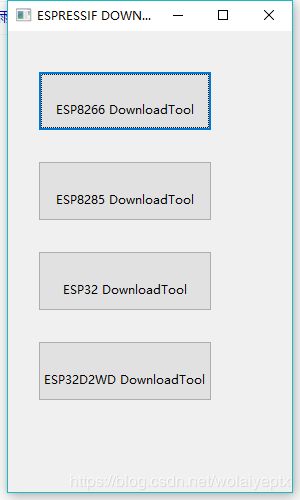Arduino UNO与ESP8266串口连接
Arduino UNO与ESP8266串口连接
- 1. ESP8266烧录AT固件
- 1.1 烧录软件下载
- 1.2 烧录AT固件
- 2. ESP8266 AT指令
- 3. Arduino UNO 串口连接方式
- 4. Arduino UNO与ESP8266-12f串口连接
- 5. 串口调试
1. ESP8266烧录AT固件
1.1 烧录软件下载
登录乐鑫官网下载地址,下载Flash 下载工具。
1.2 烧录AT固件
首先,点击安信可AT固件下载地址,下载出厂默认 AT 固件。
然后打开Flash Download Tools,点击Download ESP8266,如图所示:

在COM处选择端口号,点击START连接。此时,DETECTED INFO会显示连接的ESP8266硬件信息,包括晶振频率和Flash Size。选择DoNotChgBin,并选择下载的AT固件文件,设置地址为0x00000,设置其余参数和ESP8266信号一致。点击ERASE清空FLASH,点击START开始写入直到完成。
2. ESP8266 AT指令
| AT指令 | 第二列 |
|---|---|
| AT+CWMODE=2 | 开启 AP 模式 |
| AT+CWSAP=“ESP8266”,“0123456789”,11,0 | 设置模块的 wifi 和密码 |
| AT+CIPSERVER=1,8899 | 设置模块服务器端口 |
| AT+CIPSEND=0,11 | 进入数据发送模式为11个字节 |
| AT+CWMODE=1 | 设置模组为STA模式 |
| AT+CWLAP | 查询附近 WIFI |
| AT+CWJAP=“123123”,“12345678” | 连接 WIFI |
| AT+CIFSR | 查看路由器分配给模组的IP地址 |
| AT+CIPMUX=0 | 打开单连接 |
| AT+CIPMUX=1 | 打开多连接 |
| AT+CIPMODE=1 | 设置透传模式 |
| AT+CIPSTART=“TCP”,“192.168.43.104”,8899 | 连接手机端建立的TCP服务器 |
| AT+CIPSEND | 开始发送数据 |
| +++ | 注意退出透传,直接发送。取消发送新行 |
| AT+CIPSTART=0,“UDP”,“255.255.255.255”,50000,1000, 0 | 是建立 UDP 连接,其中手机 UDP server 设置 50000,UDP client 设置的端口 1000 |
| AT+CIPSTART=“UDP”,“192.168.43.104”,5000,2000,0 | 连接网络调试助手UDP的IP和端口 |
- 注意透传只能在单连接模式下进行,所以在建立连接之前一定要用(AT+CIPMUX=0设置单连接),但是模块处于服务器模式下时,必须要多链接,由于冲突,所以模块开启服务器模式不能做 TCP透传!
//模块通过数据外网透传
AT+CWMODE=3 设置 AP 和 STA 共存模式
AT+CWLAP 查询附近 WIFI
AT+CWJAP="HUAWEI-C4VTTJ","1234567890" 连接 wifi
AT+CIPMUX=0 设置单连接
AT+CIPMODE=1 设置透传模式
AT+CIPSTART="TCP","115.29.109.104",6602 连接外网服务器,请参考下面网址
AT+CIPSEND
3. Arduino UNO 串口连接方式
Arduino UNO ESP8266 D2-TX D3-RX 5V-Vin 3.3V-3.3V GND-GND Arduino UNO ESP8266
- D2、D3为arduino设置的软串口RX和TX。
4. Arduino UNO与ESP8266-12f串口连接
Arduino IDE官网下载连接,Arduino UNO端程序如下:
#include
#define DEBUG true
SoftwareSerial esp8266(2,3); // make RX Arduino line is pin 2, make TX Arduino line is pin 3.
// This means that you need to connect the TX line from the esp to the Arduino's pin 2
// and the RX line from the esp to the Arduino's pin 3
void setup()
{
Serial.begin(9600);
esp8266.begin(9600); // your esp's baud rate might be different
pinMode(11,OUTPUT);
digitalWrite(11,LOW);
pinMode(12,OUTPUT);
digitalWrite(12,LOW);
pinMode(13,OUTPUT);
digitalWrite(13,LOW);
sendCommand("AT+RST\r\n",2000,DEBUG); // reset module
setAP("ESP8266","w12345678");
Serial.println("Server Ready");
}
void loop()
{
if(esp8266.available()) // check if the esp is sending a message
{
if(esp8266.find("+IPD,"))
{
delay(1000); // wait for the serial buffer to fill up (read all the serial data)
// get the connection id so that we can then disconnect
int connectionId = esp8266.read()-48; // subtract 48 because the read() function returns
// the ASCII decimal value and 0 (the first decimal number) starts at 48
esp8266.find("pin="); // advance cursor to "pin="
int pinNumber = (esp8266.read()-48); // get first number i.e. if the pin 13 then the 1st number is 1
int secondNumber = (esp8266.read()-48);
if(secondNumber>=0 && secondNumber<=9)
{
pinNumber*=10;
pinNumber +=secondNumber; // get second number, i.e. if the pin number is 13 then the 2nd number is 3, then add to the first number
}
digitalWrite(pinNumber, !digitalRead(pinNumber)); // toggle pin
// build string that is send back to device that is requesting pin toggle
String content;
content = "Pin ";
content += pinNumber;
content += " is ";
if(digitalRead(pinNumber))
{
content += "ON";
}
else
{
content += "OFF";
}
sendHTTPResponse(connectionId,content);
// make close command
String closeCommand = "AT+CIPCLOSE=";
closeCommand+=connectionId; // append connection id
closeCommand+="\r\n";
sendCommand(closeCommand,1000,DEBUG); // close connection
}
}
}
void setAP(String wifi,String passwd)
{
sendCommand("AT+CWMODE=2\r\n",1000,DEBUG); // 开启 AP 模式
sendCommand("AT+CWSAP=\""+wifi+"\",\""+passwd+"\",11,0\r\n",3000,DEBUG);
}
void setSTA(String wifi,String passwd)
{
sendCommand("AT+CWMODE=1\r\n",1000,DEBUG); // 开启 STA 模式
sendCommand("AT+CWJAP=\""+wifi+"\",\""+passwd+"\"\r\n",3000,DEBUG);
delay(10000);
sendCommand("AT+CIFSR\r\n",1000,DEBUG); // get ip address
sendCommand("AT+CIPMUX=1\r\n",1000,DEBUG); // configure for multiple connections
sendCommand("AT+CIPSERVER=1,80\r\n",1000,DEBUG); // turn on server on port 80
}
/*
* Name: sendData
* Description: Function used to send data to ESP8266.
* Params: command - the data/command to send; timeout - the time to wait for a response; debug - print to Serial window?(true = yes, false = no)
* Returns: The response from the esp8266 (if there is a reponse)
*/
String sendData(String command, const int timeout, boolean debug)
{
String response = "";
int dataSize = command.length();
char data[dataSize];
command.toCharArray(data,dataSize);
esp8266.write(data,dataSize); // send the read character to the esp8266
if(debug)
{
Serial.println("\r\n====== HTTP Response From Arduino ======");
Serial.write(data,dataSize);
Serial.println("\r\n========================================");
}
long int time = millis();
while( (time+timeout) > millis())
{
while(esp8266.available())
{
// The esp has data so display its output to the serial window
char c = esp8266.read(); // read the next character.
response+=c;
}
}
if(debug)
{
Serial.print(response);
}
return response;
}
/*
* Name: sendHTTPResponse
* Description: Function that sends HTTP 200, HTML UTF-8 response
*/
void sendHTTPResponse(int connectionId, String content)
{
// build HTTP response
String httpResponse;
String httpHeader;
// HTTP Header
httpHeader = "HTTP/1.1 200 OK\r\nContent-Type: text/html; charset=UTF-8\r\n";
httpHeader += "Content-Length: ";
httpHeader += content.length();
httpHeader += "\r\n";
httpHeader +="Connection: close\r\n\r\n";
httpResponse = httpHeader + content + " "; // There is a bug in this code: the last character of "content" is not sent, I cheated by adding this extra space
sendCIPData(connectionId,httpResponse);
}
/*
* Name: sendCIPDATA
* Description: sends a CIPSEND=, command
*
*/
void sendCIPData(int connectionId, String data)
{
String cipSend = "AT+CIPSEND=";
cipSend += connectionId;
cipSend += ",";
cipSend +=data.length();
cipSend +="\r\n";
sendCommand(cipSend,1000,DEBUG);
sendData(data,1000,DEBUG);
}
/*
* Name: sendCommand
* Description: Function used to send data to ESP8266.
* Params: command - the data/command to send; timeout - the time to wait for a response; debug - print to Serial window?(true = yes, false = no)
* Returns: The response from the esp8266 (if there is a reponse)
*/
String sendCommand(String command, const int timeout, boolean debug)
{
String response = "";
esp8266.print(command); // send the read character to the esp8266
long int time = millis();
while( (time+timeout) > millis())
{
while(esp8266.available())
{
// The esp has data so display its output to the serial window
char c = esp8266.read(); // read the next character.
response+=c;
}
}
if(debug)
{
Serial.print(response);
}
return response;
}
